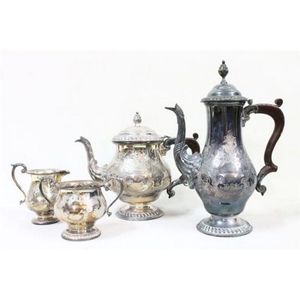Georgian Sterling Silver Wine Jug with Armorial Crest
You must be a subscriber, and be logged in to view price and dealer details.
Subscribe Now to view actual auction price for this item
When you subscribe, you have the option of setting the currency in which to display prices to $Au, $US, $NZ or Stg.
- Circa - A Latin term meaning 'about', often used in the antique trade to give an approximate date for the piece, usually considered to be five years on either side of the circa year. Thus, circa 1900 means the piece was made about 1900, probably between 1895 and 1905. The expression is sometimes abbreviated to c.1900.
- Sterling Silver - Sterling silver is a mixture of 92.5% pure silver and 7.5% of another metal, usually copper. Fine silver is 99.9% pure silver, and is relatively soft and the addition of the very small amount of copper gives the metal enough strength and hardness to be worked into jewellery, decorative and household objects.
- Engraving - The method of decorating or creating inscriptions on silver and other metal objects by marking the surface with a sharp instrument such as a diamond point or rotating cutting wheel.
- Armorial / Armourial - Bearing a coat of arms. Coats of arms came into general use by feudal lords and knights in in the 12th century, and by the 13th century, arms had spread beyond their initial battlefield use to become a flag or emblem for families in the higher social classes of Europe. They were inherited from one generation to the next. When a family crest is used on individual items of silver or furniture it is an indicator of the aristocratic standing of the family represented.
Armorials were also used to decorate mass produced ceramic souvenir ware by such companies as Goss, Carlton & Shelley, and in these cases the coats of arms displayed were of boroughs and cities. - George Iv - George IV (1762 ? 1830) was king of the United Kingdom of Great Britain and Ireland and king of Hanover from 1820, until his own death in 1830. From 1811 until his accession in 1820, he served as Prince Regent during his father's final mental illness.
In English furniture design, his reign from 1811 to 1830 is known as the Regency period.
This item has been included into following indexes:
Visually similar items

A quality William IV silver spinster's tea pot, elegant baluster form, heavily scroll floral and leaf embossed, the pedestal foot with everted acanthus leaves, sculpted floral hinge lid finial, ivory heat rings, crested. London 1836 by Joseph Angell I & Jo

English hallmarked sterling silver William IV coffee pot decorated with two bands of floral sprays of baluster form with a hinged lid, cast floral finial, an insulated handle. Both the handle & the spout decorated with anthemion leaf detail. London, 1837,

A Hardy Bros, silver plate on copper decorated Sheffiled plate tea & coffee service, comprising tea, coffee, sugar & creamer

A George IV silver coffee pot, the ovoid body with lobed shoulder and circular foot, gadrooned rim, acanthus capped spout and handle with ivory heat rings. London 1820 by Rebecca Eames & Edward Barnard. Weight 739gms
